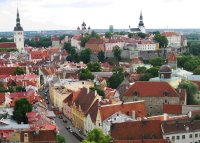Che Guevara in Estonia

 During the mid-semester break, Jane and I took Silja Line’s SuperSeaCat ferry over to Tallinn, the capital of Estonia. At the end of World War II, Tallinn was bombarded by the Red Army, but compared with other central and eastern European capitals, it has suffered relatively little over the centuries. And so it boasts one of Europe’s most celebrated medieval cores. Spires, pinnacles, and onion domes render it a kind of San Gimignano north—or “urban pin-cushion,” to steal a nice line from Lewis Mumford.
During the mid-semester break, Jane and I took Silja Line’s SuperSeaCat ferry over to Tallinn, the capital of Estonia. At the end of World War II, Tallinn was bombarded by the Red Army, but compared with other central and eastern European capitals, it has suffered relatively little over the centuries. And so it boasts one of Europe’s most celebrated medieval cores. Spires, pinnacles, and onion domes render it a kind of San Gimignano north—or “urban pin-cushion,” to steal a nice line from Lewis Mumford.Dutiful tourists that we are, we subjected ourselves to the standard forced march from pilgrimage church to crenellated tower to town hall and market square and back. All of this urban tissue is contained within a pre-gunpowder (i.e., tall and thin) wall that includes some intact gates and galleys, punctuated here and there by baroque-era fortifications, some of the bastions having long since been converted to parkland.
The Tallinn City Museum (Tallinna Linnamuuseum) depicts the city’s history “from the thirteenth century up to re-independence.” Ads assure the prospective patron that “Explanations in English have been provided in all the halls.” Tallinn was the northernmost member of the Hanseatic League, and so the city has had an international character for many centuries. Some say that the name Tallinn, or Tallinna, dates from the period of Danish domination (13th and early 14th centuries), though others insist the word is Estonian. Through most of its history the city has been known by its German name, Reval. The Estonian language is related to Finnish, though therein lies a tale.
We found it easy to get by on English alone, as nearly all merchants and hospitality workers seem to have at least some English. But we got the impression that the natives were somewhat miffed when we attempted to start a conversation with a standard Finnish opening, such as hyvää huomenta (good morning). A little Finnish at the end of a conversation was received in a decidedly different spirit. At the end of one exchange in English, for example, I began to take my leave. Kiitos, I said, hei hei. (Thank you. Bye-bye.) The merchant, solemn only moments before, repeated my words with a hearty, good-natured laugh. Kiitos. Hei hei. What could be more hilarious, he seemed to say. My suspicion is that Estonians don't like the idea that Estonian is a dialect of Finnish, which might be implied by some visiting Finns who expect the Estonians to know their language. Finns should perhaps tread lightly in Estonia—at least until everyone in both countries speaks fluent English. It won't be long.
While Tallinn appears to be a major tourist destination in the making—kind of a medieval Williamsburg—there are some distinctly non-medieval touches that add to the poignancy of the built environment. There are, for example, some of the more tawdry manifestations of a new capitalist economy. While we did not see a red-light district a la Amsterdam, there are enough strip shows and bars that the tourist bureau feels obliged to offer a discouraging word to those (namely, the English) who might think that Tallinn would be a good place to spend a weekend drinking and whoring with one’s mates. On a more mundane level, there are places such as Hell Hunt, which bills itself as Estonia’s first pub (“est. 1993”), and the Texas Honky Tonk Cantina. Tourists spending euros and U.S. dollars find many bargains in Estonia, where the locals eke out a living with their moribund kroner. We were told that some residents of Helsinki take the ferry to Tallinn just to buy booze.
The rawness of emerging capitalism in a former east-bloc country is underscored by the stark generational contrast provided by legions of young people with nose studs and tattoos sharing the streets of the old town with babushkas exercising their rosaries. The older generation is likely to speak some Russian. Young people almost certainly will speak at least some English. Meanwhile, the older generation of ethnic Russians in Tallinn, who may have never learned to speak Estonian, must watch helplessly as their heirs become more assimilated (i.e., less Russian) and more cosmopolitan by the day.
The signs of change are everywhere. At present, Tallinn is a city of scaffolding. The new president of Estonia, the 53-year-old Toomas Hendrik Ilves, grew up in the United States, where he earned psychology degrees from Columbia and Penn. According to the tourist bureau, he is fond of bow ties.
Running against the grain of rampant capitalism and post-modernity is the occasional element of exotica. Consider, for example, the Museum of Occupation and of the Fight for Freedom, which covers the “difficult period” during which Estonia was occupied by Nazi Germany and then, along with the other Soviet socialist republics, ground beneath the iron heal of the U.S.S.R.
At Pagari 1 is the former headquarters of the KGB. The complimentary guide book called Tallinn in Your Pocket notes, “Look for the building with the bricked-up cellar windows.” The plaque there reads, “This building housed the headquarters of the organ of repression of the Soviet occupational power. Here began the road to suffering for thousands of Estonians.”
Then there is the Bronze Soldier in front of the National Library. This monument, which dates from 1947, officially commemorates Soviet soldiers killed in World War II, but it has become identified with the occupation, and so it is the focal point for political rallies, “especially by Estonian extremists who want to see it removed.”
In this particular context, what are we to make of the Che Guevara stencil that we saw on an old town sidewalk? It was fresh. It’s hard to think that the Che icon can be taken literally, but then, how is one to take it? And what might have been the motives of the sidewalk spray-paint artist?


2 Comments:
Che Guevara has become a popular fashion icon in England...I don't remember the brand, but his face is just about everywhere. When I was in London in June, one of the shops along Oxford Street had a display of Che shirts in its window (at the time, I was more interested in the fact that it was the only store not displaying World Cup-related fashions). Che in Tallinn is just further evidence of their integration with the rest of Europe.
Many thanks for your note on Che in Tallinn. I'll try not to take these things so literally, then. Hei hei.
Post a Comment
<< Home